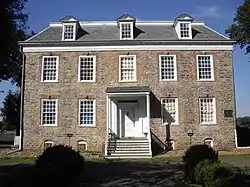Van Cortlandt House Museum
The Van Cortlandt House Museum, also known as the Frederick Van Cortlandt House or simply the Van Cortlandt House, is the oldest building in the borough of the Bronx in New York City. It is located in the southwestern portion of Van Cortlandt Park, accessed via Broadway (U.S. Route 9).
Van Cortlandt House | |
 The mansion in 2008 | |
| Location | Van Cortlandt Park, Bronx, New York City |
|---|---|
| Coordinates | 40°53′24″N 73°53′47″W |
| Area | 192 acres (78 ha) |
| Built | 1748 |
| Architectural style | Georgian |
| NRHP reference No. | 67000010 |
| NYSRHP No. | 00501.000009 |
| NYCL No. | 0127, 0890 |
| Significant dates | |
| Added to NRHP | December 24, 1967[1] |
| Designated NHL | December 24, 1976[2] |
| Designated NYSRHP | June 23, 1980 |
| Designated NYCL | March 15, 1966 (facade) July 22, 1975 (interior) |
History
The house was built in 1748 in the Georgian style by Africans enslaved by Frederick Van Cortlandt (1699–1749) for his family. Van Cortlandt died before its completion and the property was inherited by his son, James Van Cortlandt (1727–1781). Following his death, it was inherited by his younger brother, Augustus Van Cortlandt, the City Clerk of New York. It is a 2+1⁄2-story, L-shaped house with a mansard roof. It was built of dressed fieldstone and is one of the nation's finest examples of the high Georgian style in stone.[3]
The Van Cortlandts, a mercantile family prominent in New York affairs, established a grain plantation and grist mill on the property. The house was used during the Revolutionary War by the Comte de Rochambeau, Marquis de Lafayette, and George Washington.[2]
Ownership
Upon its initial construction, the house passed through successive family ownership from 1748 to 1888 by:
- 1748–1749: Frederick Van Cortlandt
- 1749–1781: James Van Cortlandt
- 1781–1823: Augustus Van Cortlandt
- 1823–1839: Augustus White Van Cortlandt
- 1839–1839: Henry White Van Cortlandt
- 1839–1884: Augustus Bibby Van Cortlandt
Historic house museum
In 1889, the family sold the property to the City of New York as part of Van Cortlandt Park's creation. The house has been operated as a historic house museum since 1897, the first in the city and fourth in the country.[4]
It was added to the National Register of Historic Places in 1967 and became a National Historic Landmark in 1976.[5]
Gallery
- Historic American Buildings Survey, 1937
 General view from Southwest
General view from Southwest View from Southwest
View from Southwest View from the West
View from the West Entrance detail
Entrance detail Dining room fireplace
Dining room fireplace Fireplace
Fireplace Kitchen
Kitchen Parlor fireplace
Parlor fireplace
- Present day
 Dining room fireplace and built-in cupboard
Dining room fireplace and built-in cupboard Dining room
Dining room Delft tile surrounding fireplace
Delft tile surrounding fireplace Piano in the museum
Piano in the museum
References
- "National Register Information System". National Register of Historic Places. National Park Service. January 23, 2007.
- "Van Cortlandt House". National Historic Landmark summary listing. National Park Service. September 22, 2007. Archived from the original on June 6, 2011.
- Patricia Heintzelman (May 1975). "National Register of Historic Places Registration: Frederick Van Cortlandt House". New York State Office of Parks, Recreation and Historic Preservation. Retrieved January 12, 2011.
- "The Van Cortlandt House Museum". City of New York Parks Department. Retrieved January 19, 2009.
- National Park Service, National Historic Landmark Survey, New York, retrieved June 3, 2007.
External links
- Official website
- Historic American Buildings Survey (HABS) No. NY-455, "Frederick Van Cortlandt Mansion, Broadway & Two-hundred-forty-second Street, Bronx, Bronx County, NY", 8 photos, supplemental material
- Van Cortlandt Park, New York City Department of Parks & Recreation
- Death in the Bronx, The Stockbridge Indian Massacre, August 31, 1778

